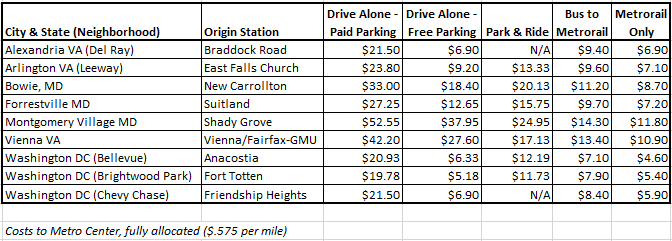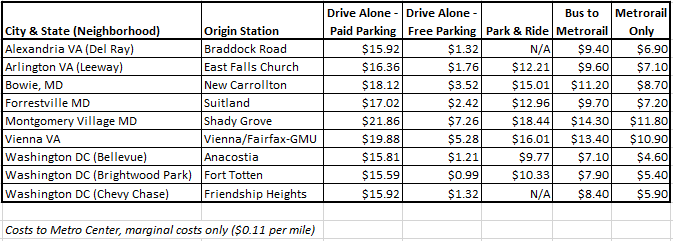News Flash – Driving is Still More Expensive than Transit!
Now that gas is at historic lows, isn’t it cheaper to drive and park than take transit? Probably not!
The Office of Planning staff often helps get new Board Members acquainted, and we recently had the pleasure to participate in a portion of Board Member Malcolm Augustine‘s orientation. During our lengthy conversation, the familiar refrain of gas prices and parking costs vs. Metrorail fares and parking fees came up. Are low gas prices and cheap parking taking trips off the rails?
We’ve looked at this issue in the past and reported out that declining gas prices have not historically nor do they do now seem to have a meaningful negative impact on Metorail ridership. We’re continuing to track these datapoints as we keep our finger on the pulse of Metrorail ridership. But we also hear that trips are very personal, and even though the big picture data doesn’t show it – and even the American Automobile Association has denied it – might driving be getting cheaper than taking transit?
Survey says – not likely.
Using the cost comparison calculator available on our website, we have constructed some sample origin-destination pairs for illustration sake. The first table compares the fully-loaded cost of driving (including depreciation, insurance, etc.) against the cost of taking an equivalent transit trip. Some data notes:
- The costs of driving include a per-mile cost of $0.575, which is the current GSA cost that includes gas, insurance, depreciation and maintenance
-
The cost of parking downtown is assumed to be $14.60 per day, based on a $292 monthly rate (daily parking downtown without a monthly contract costs $25 per day)
- The cost estimates for Park & Ride assume driving and parking at Metrorail stations, with the same per-mile rate applied to the drive to the station
-
The specific costs of parking at each individual station and the peak fare to Metro Center were used
- Bus & Ride costs assume a Metrobus fare with transfer discount of $1.25, plus the peak period rail fare

This second table nets out the “hidden costs” of driving and uses only the marginal cost, which is essentially the cost of fuel.

More than a few things stand out, but it is clear that overall, people come out ahead when taking transit. Even when we only compare the marginal cost of the trip (just the gas prices). Of course, this subset only looks at longer-distance trips – the cost of a Capital Bikeshare trip vs. a peak period rail fare would tilt towards CaBi, but this post is about gas prices, and to our knowledge, Capital Bikeshare trips don’t require gas. It is telling, however, to look at the marginal cost of a bus & ride trip compared to the marginal cost of a vehicular trip with free parking. The data says that if a customer is choosing between driving to a “free” or otherwise fully-subsidized parking spot, vs. taking a bus to Metorail, the customer would probably choose to drive, on the margins.
Try it yourself to see whether your trip is cheaper on transit! Customers can assess the potential cost savings of taking Metrorail versus driving for their commuter trips by using the Savings Calculator available under “Rider Tools” on wmata.com.


Something’s off on the drive alone formulas. I expected a difference of $14.60 in both tables between paid parking downtown and free parking downtown, but that’s not true.
Good catch, @Andrew! It turns out we were underestimating our drive plus paid parking costs. We’ve updated the tables to reflect the full costs.
As long as you are trying to account for everything, what about the value of one’s time?
If we already own cars and are paying insurance, depreciation, etc it does not make much sense to let them (cars) sit and rot at home and take another more expensive option (Metro) that wastes a ton of time.
On a good day taking Metro, with no delays, offloads, etc my round trip commute time is 2.5 hours. Same time in the car is 1.15 hours. And, in the car I listen to my music, have a guaranteed seat, am not going to be robbed or otherwise experience bodily harm due to deteriorating infrastructure (Red line, anyone?), don’t stand in the cold/hot/rain/etc, [this comment was removed for violating our comment policy. See the about page], and if I want to eat a french fry w/o being arrested, I can.
Until Metro can root out it’s corruption problem and bring fares down to a reasonable level commensurate with the size and scale of WMATA I won’t be riding. How can NYC operate a subway system with no “rush plus”, $2 take-me-anywhere tickets, and zero passenger fatalities but Metro can’t (for 3X the price!)?
What this bogus cost comparison says is that if you live at a Metrorail station, your auto vs. Metro costs will be higher. It does not address the fact that most people in the WDC area do not live near a Metro station, must drive to get there (some may bus), and therefore must own and operate their own car. It also does not consider the flexibility, reliability, and comparative comfort (even health-related breathing in a crammed Metro railcar during cold/flu season) offered by one’s own car (or a carpool) in commuting.
C’mon, quit cherry picking.
And I work from home.
@mick Excellent point. The previous work we did on the Regional Benefits of Transit modeled the amount of time wasted on regional roadways and attributed a monetary value to that. It’s an amazingly large number – and climbing!
@Terry You do raise the important point that despite the fact that Metrorail carries around 700,000 trips per weekday and Metro as a whole connects to 52% of the region’s job base, it is really physically connected to less than 5% of the region’s land area. It’s doing a lot of heavy lifting, despite its very limited footprint!
May I simply say what a comfort to discover somebody who really knows what they are talking about
on the net. You actually know how to bring an issue
to light and make it important. More and more people must look at this and
understand this side of your story. I was surprised you aren’t more
popular given that you certainly possess the gift.
@Ian
Thanks for chiming in here! Note that the first table compares the “loaded” costs, including the items you mention. Because most travelers make decisions “on the margins”, the second table compares the costs of taking Metro vs. just the cost of gas consumed – at today’s low gas prices.